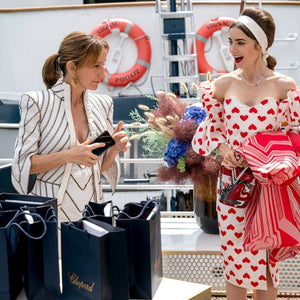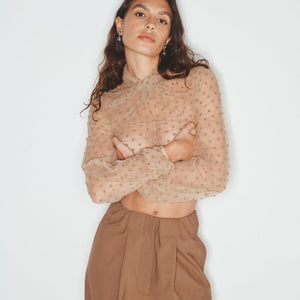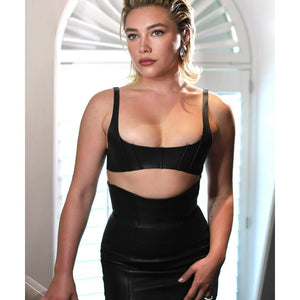
Instagram/@abercrombie
In 1853, Levi Strauss filed a historic patent for riveted denim work pants that would one day become a universal emblem of cool. But how did utilitarian jeans initially designed for miners and laborers become an endlessly reinvented icon seen on catwalks from Paris to New York? Denim's journey from workwear staple to runway essential charts a fascinating path across cultural transformations of class, music, movies, environmentalism and more.
Workwear Roots

The first jeans were created for hardworking men like miners and railroad mechanics. Levi.com
The origins of denim as we know it today lie in the mines of the American Wild West. The California Gold Rush of the mid-1800s fueled demand for strong, durable pants that could withstand heavy pickaxes and long days caked in mud. In 1871, Levi Strauss & Co. responded with the first riveted jeans made from warp-faced twill denim fabric. The innovative metal rivets reinforced stress points, while the unusual seams added even more resilience to an already weighty fabric. With multiple deep pockets and a built-in belt loop for tools, the original Levi's 501 jeans were the very model of form following utilitarian function.
From the beginning, denim carried strong associations with humble labor. The rich indigo dye concealed stains and wear—a valuable trait for mining, agriculture and industrial workers who needed minimum-maintenance clothing. The cotton fabric breathed well and softened into creased, body-molded shapes from constant wear. In short, denim's early positioning was definitively functional and working class.
Rebel Cool Factor

Marlon Brando on "The Wild One" set wearing jeans. Bettmann
How then did denim shed its proletarian image to become an emblem of youthful cool? The answer lies in the magic of Hollywood and the allure of celebrity style. In 1955, Rebel Without a Cause seared the smoldering image of James Dean in denim into public consciousness forever. Along with Marlon Brando's provocative jeans and white T-shirt uniform, these portrayals galvanized denim as the uniform of renegade outsiders who rejected societal norms. Denim graduated from workwear to a symbol of insurgence.
The rebellious aura of denim only intensified into the 1960s and 70s. The hippie counterculture embraced jeans as an iconoclastic alternative to the formal mainstream attire, customizing them with embroidery, patches and bellbottoms. Denim-clad music icons like Bob Dylan and the Rolling Stones made them the unofficial uniform of rock and roll edge. By the 1980s and 90s, denim had permeated nearly every subculture from hip hop to heavy metal to grunge. Each group reinterpreted jeans in their distinctive voice, from baggy rapper silhouettes to thrashed and ripped punk styles.
Designer Denim Explosion

Brooke Shields in Calvin Klein ad. Calvin Klein
The late 20th century marked a seismic shift as denim infiltrated the upper echelons of fashion. 1976 saw the release of the first "designer jeans" by Calvin Klein and others at $50 per pair—an unthinkably lavish sum compared to the $10 or less most paid for generic jeans. By 1980, Calvin Klein upped the ante with its provocative Brooke Shields commercial that proclaimed, "Nothing comes between me and my Calvins."
Seemingly overnight, jeans went from a symbol of working-class grit to a status symbol. To own designer denim conveyed access, influence, and insider fashion knowledge. The rise of "It Jeans" (think the frenzy over Guess and Jordache in the 80s) marked a growing obsession with provenance and labels when it came to denim.
Eco-Ethical Concerns

Denim production (as well as the whole textile industry) raises lots of ecological concerns, but at least there are some manufacturers trying to use organic or recycled cotton. Instagram/@kuyichipuregoods
But the designer denim explosion came at a cost. The media spotlight on premium denim illuminated the environmental and ethical issues surrounding its manufacture. The conventional process of making a single pair of jeans consumes a staggering 1500 gallons of water and over 50 pounds of noxious chemicals. Considering that millions of cheap, trend-driven "disposable fashion" pairs are manufactured annually, the ecological footprint compounds.
In response to growing outcry, a new wave of eco-ethical denim brands arose in the 1990s and early 2000s. Labels like Kuyichi and Kuypers pioneered organic cotton jeans, dramatically lowering water and pesticide use in the process. Meanwhile, companies like Nudie and Patagonia introduced recycled denim collections that repurposed post-consumer waste. While "greenwashing"—misleading marketing that claims a green halo for essentially unchanged products—remains a concern, innovative new distressing methods, dyes and fibers point toward a cleaner denim future.
Runway Reinventions

Anne Hathaway wearing denim corset, dramatic denim skirt (both by Ralph Lauren) and real diamonds (Bulgari) on the 2023 CFDA Awards. Getty Images
But for all the focus on its workaday past or its technical future, denim has also earned its place as a high-fashion mainstay through ceaseless reinterpretation. Modern couturiers from Dries van Noten to Alexander McQueen have both upended and celebrated denim tropes, treating them as rich cultural material to reference and reinvent.
Patched, destroyed, dark-washed, coated, printed—on the runway, denim becomes a protean building block for endless experimentation. Hybrid constructions fuse denim with lace, leather, silk, fur and technical fabrics. Age-old work jacket and dungaree patterns reappear in altered volumes and proportions, manipulated into cutaway shapes and avant-garde silhouettes. Of-the-moment washes and finishes take inspiration from subcultures across eras, from rockabilly cuffs to raver wide-legs.
Workwear to Runway

Isabelle Huppert rocking Balenciaga denim skirt and denim jacket worn backward at 2025 Cannes Film Festival. Earl Gibson III/Deadline
By merging mass appeal with exclusivity, rebellion with tradition, utilitarianism with style, denim has proven itself perhaps the most versatile, and dynamic, textile of the modern age. Its remarkable ability to shapeshift between identities has made it a lasting nexus for fashion's creative forces. And yet, through it all, denim has never lost its egalitarian soul.
As fashion cycles accelerate and denim washes and cuts evolve at a dizzying pace, the primordial allure of a perfect pair of broken-in jeans endures. So does denim's unique power to telegraph authentic individuality through every crease, fade and rip we wear into it. Therein lies the secret to its astounding longevity.




